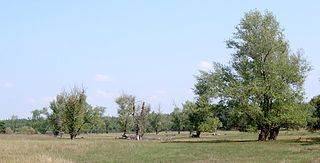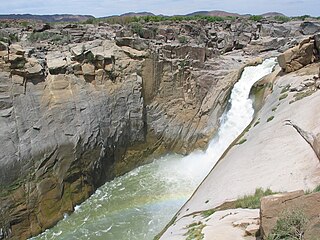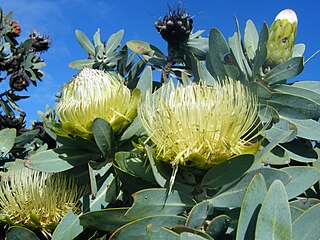
Pachypodium is a genus of succulent spine-bearing trees and shrubs, native to Madagascar and Africa. It belongs to the family Apocynaceae.

Platanus racemosa is a species of plane tree known by several common names, including California sycamore, western sycamore, California plane tree, and in North American Spanish aliso. Platanus racemosa is native to California and Baja California, where it grows in riparian areas, canyons, floodplains, at springs and seeps, and along streams and rivers in several types of habitats. It has been found as far north as Tehama and Humboldt counties.

Populus nigra, the black poplar, is a species of cottonwood poplar, the type species of section Aigeiros of the genus Populus, native to Europe, southwest and central Asia, and northwest Africa.

Brachystegia spiciformisBenth., commonly known as zebrawood, or Msasa, is a medium-sized African tree having compound leaves and racemes of small fragrant green flowers. The tree is broad and has a distinctive amber and wine red colour when the young leaves sprout during spring (August–September). It grows in savanna, both open woodland and closed woodland of Southern and Eastern Africa, mostly Tanzania, Zambia, Zimbabwe, Malawi and Mozambique. The word Msasa is commonly used as a proper name in African place names. The word also means 'rough plant' in Swahili. Other common names: Mundu, Myombo, Mtondo (Tanzania), Muputu (Zambia). The plant is known in the Venda language as mutsiwa, which means 'the one that is left behind'. An outlying population of Brachystegia has recently been discovered in the Soutpansberg mountains of northern South Africa. This tree is a protected species in South Africa.

Brachystegia tamarindoides Benth., known as mu'unze and also as the mountain acacia is a medium-sized tree with smooth grey bark, bluish-green leaves and small creamy-white flowers that produce copious amounts of pollen and nectar. It is almost always very close to upturned umbrella shaped with a partially developed flat top, making it easy to recognise in mixed woodland. In this it differs from most of the other Brachystegia species that have variable shapes. The leaves are feathery in appearance, with around 10-12 leaflets arrayed along each leaf stalk.

The silk floss tree is a species of deciduous tree native to the tropical and subtropical forests of South America. It has several local common names, such as palo borracho, samu'ũ or paineira. In Bolivia, it is called toborochi, meaning "tree of refuge" or "sheltering tree". It belongs to the same family as the baobab and the kapok. Another tree of the same genus, Ceiba chodatii, is often referred to by the same common names.

Agonis flexuosa is a species of tree that grows in the south west of Western Australia. It is easily the most common of the Agonis species, and is one of the most recognisable trees of Western Australia, being commonly grown in parks and on road verges in Perth.

Augrabies Falls National Park is a national park located around the Augrabies Falls, about 120 km west of Upington in the Northern Cape Province, South Africa. It was established in 1966.

Acacia mearnsii, commonly known as black wattle, late black wattle or green wattle, is a species of flowering plant in the family Fabaceae and is endemic to south-eastern Australia. It is usually an erect tree with smooth bark, bipinnate leaves and spherical heads of pale yellow or cream-coloured flowers followed by black to reddish brown pods. In some other parts of the world, it is regarded as an invasive species.

Leucosidea sericea, commonly known as ouhout in Afrikaans, is an evergreen tree or large shrub that grows in the Afromontane regions of southern Africa. It is the sole species in the genus Leucosidea. The English name "oldwood" is simply a direct translation of the Afrikaans words "ouhout" or "oudehout", meaning the same thing. This name may reflect the fact that the wood burns slowly as if old and rotting, but the gnarled twisted trunks reinforce this impression.

Protea neriifolia, also known as the narrow-leaf sugarbush, oleander-leaved sugarbush, blue sugarbush, or the oleanderleaf protea, is a flowering plant in the genus Protea, which is endemic to South Africa.

The white-bellied sunbird, also known as the white-breasted sunbird, is a species of bird in the family Nectariniidae. It is found in Angola, Botswana, Democratic Republic of the Congo, Malawi, Mozambique, Namibia, South Africa, Swaziland, Tanzania, Zambia, and Zimbabwe.
Julbernardia paniculata is a medium to large tropical tree, also known as muchesa. It is widespread over the warmer parts of south tropical Africa, preferring moderately high altitudes, typically 1,000 to 1,200 metres. It is very common over its range and is the dominant woodland tree in Miombo woodland over much of central Zambia and northern Malawi.

Xylococcus is a monotypic genus of flowering plants in the heath family which contains the single species Xylococcus bicolor, the mission manzanita.

Aloe excelsa is an arborescent aloe indigenous to southern Africa.

Leptospermum lanigerum, commonly known as the woolly teatree, is a small tree or medium shrub from the plant family Myrtaceae. Its common name derives from the conspicuously hairy capsules produced as fruit, along with the fine, silky hairs present on branches and leaves. L. lanigerum is widespread in many habitats, particularly in waterlogged areas such as moist, sandy coastal heaths, on river banks, riparian scrub, woodlands and on the fringe of montane grasslands. This species is endemic to Australia, with native populations occurring in New South Wales, South Australia, Tasmania and Victoria.

Protea nitida, commonly called wagon tree, waboom or blousuikerbos, is a large, slow-growing Protea endemic to South Africa. It is one of the few Protea species that grows into trees, and the only one that has usable timber.

Acer palmatum, commonly known as Japanese maple, palmate maple, or smooth Japanese maple, is a species of woody plant native to Japan, Korea, China, eastern Mongolia, and southeast Russia. Many different cultivars of this maple have been selected and they are grown worldwide for their large variety of attractive forms, leaf shapes, and spectacular colors.

Albizia gummifera is a species of legume in the family Fabaceae, native to sub-saharan Africa and Madagascar, and naturalized in Brazil. It is also known as peacock flower.

Schotia afra is a flowering plant in the legume family, Fabaceae. It belongs to the subfamily Detarioideae. It occurs in Southern Africa. The genus was named for Richard van der Schot by Jacquin who was the director of the Imperial Gardens at Schönbrunn Palace, Vienna. Van der Schot was his head gardener.






















